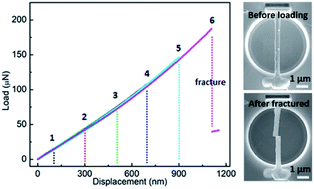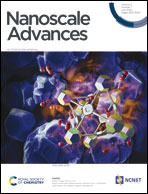Effect of Fe-doping on bending elastic properties of single-crystalline rutile TiO2 nanowires†
Abstract
Transition-metal-doping can improve some physical properties of titanium dioxide (TiO2) nanowires (NWs), which leads to important applications in miniature devices. Here, we investigated the elastic moduli of single-crystalline pristine and Fe-doped rutile TiO2 NWs using the three-point bending method, which is taken as a case study of impacts on the elastic properties of TiO2 NWs caused by transition-metal-doping. The Young's modulus of the pristine rutile TiO2 NWs decreases when the cross-sectional area increases (changing from 246 GPa to 93.2 GPa). However, the elastic modulus of the Fe-doped rutile NWs was found to increase with the cross-sectional area (changing from 91.8 GPa to 200 GPa). For NWs with similar geometrical size, the elastic modulus (156.8 GPa) for Fe-doped rutile NWs is 24% smaller than that (194.5 GPa) of the pristine rutile TiO2 NWs. The vacancies generated by Fe-doping are supposed to cause the reduction of elastic modulus of rutile TiO2 NWs. This work provides a fundamental understanding of the effects of transition-metal-doping on the elastic properties of TiO2 NWs.



 Please wait while we load your content...
Please wait while we load your content...